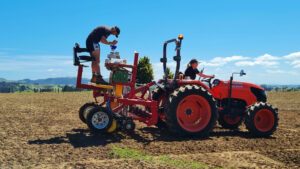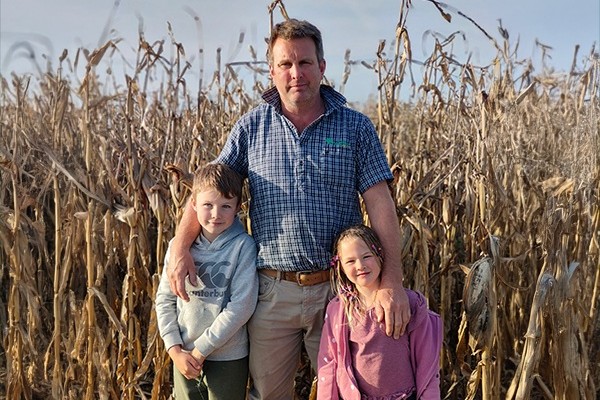Crop mixes of up to 11 species are being tested in a series of trials in the Waikato to build pastures safe for wet or dry summers. By Delwyn Dickey.
Having to fork out for supplementary feed for calves in the middle of a hot summer, when the paddocks are struggling, can be rustrating and expensive. Especially with increasing droughts and changing rainfall patterns forecast for the northern North Island.
Coming up with more resilient pastures and cropping options instead of relying on supplements makes good sense, AgFirst consultant Phil Weir says.

A new six month trial underway, using funding from Our Land and Water, hopes to come up with ‘summer safe’ seed mixes that would be able to handle not just drier summer and autumn conditions, but also wet ones. Cropping mixes of up to 11 species will be looked at for farmers raising dairy calves. They need to be easy to use with as little labour as possible, Phil says.
Rather than year round pastures, these are single graze mixes that combine crop, cereal and pasture species without any extra supplements needing to be fed out from January through to mid-March, taking advantage of spring rains to get the crops up and running.
Along with farm advisory work Phil also runs a contract grazing business raising dairy beef calves for beef. The trial will be run on his property in the Waikato.
From a business perspective he wants to know if there is any advantage in adding multiple species of plants that grow well in the area instead of mono-crops like kale. Does it result in less pest pressure, less weed burden, less spraying, and what are the yields like, he says. “Basically, which one is going to give you the cheapest drymatter.”
The cost of post-emergence spraying is something he is particularly interested in as he’s always been “on the fence” about this type of spraying. He intends to leave half of some of the trial crops without spray to see if its needed at all with multiple species. If not, this could save spray costs and labour. It would also produce lower emissions with less tractor use.
A neighbouring farmer’s dairy calves will be run on the crops. If they are clearly not doing well they will be replaced with older dairy heifers, Phil says.
Ryegrass is not drought-tolerant and is running foul of hotter and drier Northland and northern Waikato summers-autumns. In an effort to combat this and fill in the feed gap, the team will be combining plant species that have different growth characteristics above and below ground, Dr Katherine Tozer with AgResearch says, to make good use of the soil water and nutrients. The same applies to plant material above ground, with different growth habits to capture as much light as possible.
Some of the 12 different mixes are straight crop species while others will combine with perennial pasture species and cereals like oats.
Katherine is also keen to see the results of a couple of smaller trials running alongside that will look at how well different species ‘play’ together.
Using plantain, rape, red clover and oats species, small blocks are planted in the different mono-cultures (single species), while other blocks have all the species in different proportions.
If the DM coming off the combined blocks is more than the DM from the monocultures this means they have a positive effect on each other – they’re good buddies and encourage each other. If it’s less they have a negative effect – they clash and need to be separated. This should help Katherine predict how they will grow together compared to when they are used as a mono-culture crop.
Having different combinations of plants helps meet the livestock needs for energy and fibre while producing lots of dry matter. Having the variety should also counter some of the metabolic issues that can show up in cattle when only feeding on mono-culture crops.
Part of the trial also looks at a 12 species mix and a 20 species mix to see if there is any benefit from lots of variety or if benefit will come down to specific species being more important. At this stage Katherine is more inclined to think it will come down to specific species.
They’re using plants they know will do well in the upper North Island, do well in a grazed environment, and have certain characteristics that will fill that summer-autumn feed gap, she says.
- Also involved with the project are Agricom New Zealand , PGG Wrightson Seeds, and Farmlands Co-operative Society.





